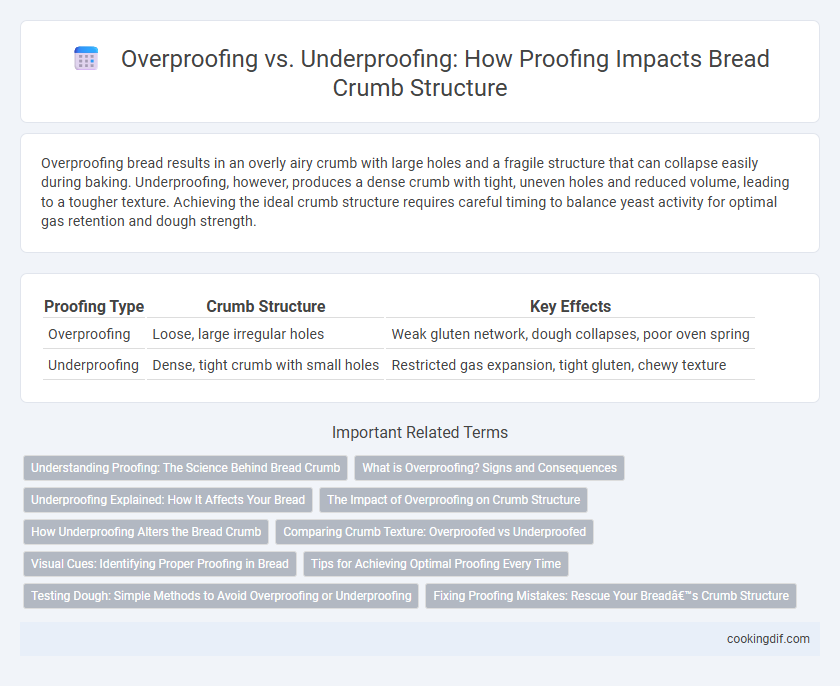Overproofing bread results in an overly airy crumb with large holes and a fragile structure that can collapse easily during baking. Underproofing, however, produces a dense crumb with tight, uneven holes and reduced volume, leading to a tougher texture. Achieving the ideal crumb structure requires careful timing to balance yeast activity for optimal gas retention and dough strength.
Table of Comparison
| Proofing Type | Crumb Structure | Key Effects |
|---|---|---|
| Overproofing | Loose, large irregular holes | Weak gluten network, dough collapses, poor oven spring |
| Underproofing | Dense, tight crumb with small holes | Restricted gas expansion, tight gluten, chewy texture |
Understanding Proofing: The Science Behind Bread Crumb
Understanding proofing is crucial for achieving the ideal bread crumb structure, as overproofing causes excessive fermentation leading to large, irregular holes and a weak crumb that collapses easily. Underproofing results in dense, tight crumbs due to insufficient gas production and minimal gluten development. Controlling proofing time optimizes yeast activity and gluten elasticity, producing a balanced crumb with desirable texture and even air pockets.
What is Overproofing? Signs and Consequences
Overproofing occurs when bread dough ferments too long, causing excessive yeast activity that weakens gluten structure. Signs include a dough that is overly soft, flattened, or collapsing, leading to large air pockets and a coarse, uneven crumb texture. Consequences of overproofing result in a loaf with poor volume, dense or gummy areas, and an overall compromised crumb quality.
Underproofing Explained: How It Affects Your Bread
Underproofing occurs when dough hasn't fermented long enough, resulting in limited gas production and a dense, tight crumb structure. This incomplete fermentation causes insufficient gluten development, yielding bread with a heavy texture and reduced oven spring. Proper timing ensures an open, airy crumb by allowing yeast activity to maximize gas retention and gluten elasticity.
The Impact of Overproofing on Crumb Structure
Overproofing causes excessive yeast fermentation, leading to weakened gluten networks and large air pockets that result in a crumb structure with uneven holes and a gummy texture. The dough becomes overly relaxed, losing its ability to trap gases properly, which negatively impacts oven spring and produces a dense, collapsed crumb. Understanding the precise timing of proofing is essential for achieving a balanced, open crumb with desirable softness and chewiness.
How Underproofing Alters the Bread Crumb
Underproofing leads to a dense and gummy crumb structure due to insufficient gas production and expansion during fermentation. The dough lacks the necessary time to develop air pockets, resulting in tight, heavy texture with irregular holes. This results in bread that is chewy and less flavorful, as the yeast activity is not fully completed.
Comparing Crumb Texture: Overproofed vs Underproofed
Overproofed bread often results in a crumb structure that is overly airy and irregular with large, uneven holes, compromising its chewiness and flavor. Underproofed bread tends to have a dense, tight crumb with smaller, uniform holes, leading to a heavier texture and less oven spring. Comparing crumb texture reveals that balanced proofing produces an ideal open crumb and optimal softness in the final bread.
Visual Cues: Identifying Proper Proofing in Bread
Proper proofing in bread is visually indicated by a smooth, slightly domed surface with subtle cracks, signaling optimal yeast activity and gluten development. Overproofed dough appears overly expanded with large bubbles and a weak structure prone to collapsing during baking. Underproofed bread shows dense, tight crumb with minimal rise, reflecting insufficient fermentation and underdeveloped gluten strands.
Tips for Achieving Optimal Proofing Every Time
Achieving optimal proofing ensures the best crumb structure by balancing overproofing and underproofing; overproofed dough results in a weak, overly airy crumb, while underproofed dough leads to dense, tight crumbs. Monitor dough volume closely, usually allowing it to double for most bread types, and perform the finger poke test to check elasticity--if the indentation springs back slowly, proofing is ideal. Maintain consistent temperature and humidity, and avoid rushing the process to develop flavor and proper crumb texture every time.
Testing Dough: Simple Methods to Avoid Overproofing or Underproofing
Testing dough for proper proofing can be done by performing the finger dent test, where a gentle poke leaves a slight indentation that slowly springs back, indicating optimal fermentation. Overproofed dough will collapse or leave a dent that doesn't spring back, resulting in a weak crumb structure with large, irregular holes. Underproofed dough resists indentation and produces a dense crumb with tight, uneven air pockets.
Fixing Proofing Mistakes: Rescue Your Bread’s Crumb Structure
Overproofing causes excessive gas bubbles, resulting in a crumb with large holes and a weakened structure, while underproofing yields dense, tight crumbs due to insufficient fermentation. To rescue overproofed dough, gently reshape and allow a shorter second proof to regain balance, whereas underproofed dough benefits from extended proofing at a controlled temperature to develop gas and improve crumb texture. Monitoring dough temperature and proofing time precisely ensures optimal yeast activity and a desirable airy, uniform crumb structure.
Overproofing vs Underproofing for crumb structure Infographic

 cookingdif.com
cookingdif.com